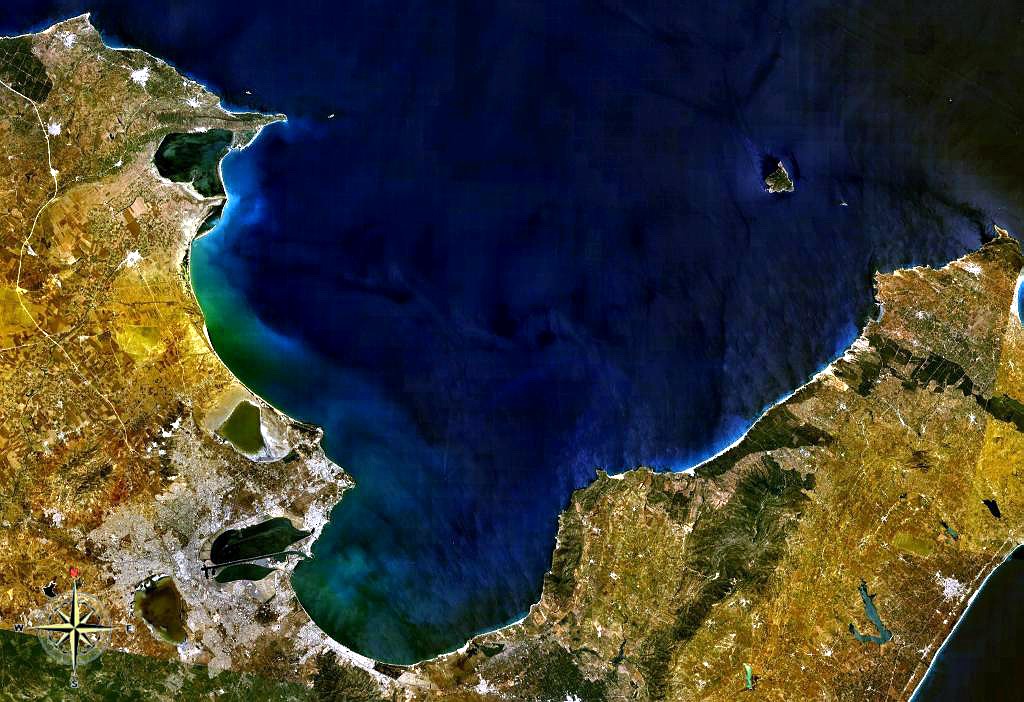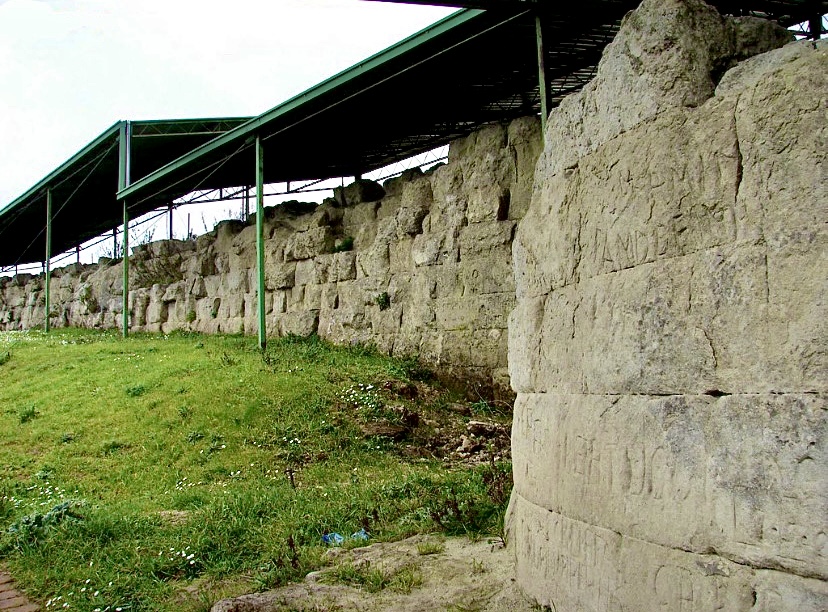|
Gulf Of Saint Euphemia
The Gulf of Saint Euphemia (, ) is a gulf on the west coast of Calabria, southern Italy. It is part of the Tyrrhenian Sea and borders the province of Cosenza, the province of Catanzaro, and the province of Vibo Valentia. Geography The gulf extends from Campora San Giovanni in the north to Capo Vaticano in the south. The rivers Savuto, Amato, and Angitola flow into the gulf. Some of the important towns and cities near the gulf include Lamezia Terme, Vibo Valentia, and Tropea Tropea (; ; ; ) is a municipality in the province of Vibo Valentia, in the Italian region of Calabria. It is one of I Borghi più belli d'Italia ("The most beautiful villages of Italy"). Tropea is a seaside resort with sandy beaches, located on .... The land bordering the gulf is mountainous in the north and south with a plain in the middle. A relatively narrow isthmus lies between the Gulf of Saint Euphemia and the Gulf of Squillace. References Gulfs of Italy Gulfs of the Mediterranean Landform ... [...More Info...] [...Related Items...] OR: [Wikipedia] [Google] [Baidu] |
Calabria
Calabria is a Regions of Italy, region in Southern Italy. It is a peninsula bordered by the region Basilicata to the north, the Ionian Sea to the east, the Strait of Messina to the southwest, which separates it from Sicily, and the Tyrrhenian Sea to the west. It has 1,832,147 residents as of 2025 across a total area of . Catanzaro is the region's capital. Calabria is the birthplace of the name of Italy, given to it by the Ancient Greeks who settled in this land starting from the 8th century BC. They established the first cities, mainly on the coast, as Greek colonisation, Greek colonies. During this period Calabria was the heart of Magna Graecia, home of key figures in history such as Pythagoras, Herodotus and Milo of Croton, Milo. In Roman times, it was part of the ''Regio III Lucania et Bruttii'', a region of Roman Italy, Augustan Italy. After the Gothic War (535–554), Gothic War, it became and remained for five centuries a Byzantine empire, Byzantine dominion, fully recove ... [...More Info...] [...Related Items...] OR: [Wikipedia] [Google] [Baidu] |
Lamezia Terme
Lamezia Terme (), commonly called Lamezia, is an Italian city and ''comune'' of 70,452 inhabitants (2013), in the province of Catanzaro in the Calabria region. History The municipality of Lamezia Terme was formally created on 4 January 1968. Its territory includes those of the former municipalities of Nicastro, Sambiase and Sant'Eufemia Lamezia. Nicastro Nicastro's origins trace back to the 9th century, when Calabria was part of the Byzantine Empire, when a fortress called ''Neo Castrum'' ("New Castle") was created. A great Benedictine abbey, St. Eufemia, was founded here in 1062 by the Norman count Robert Guiscard. It was for a long time a fief of the Caracciolo family and, later, to the D'Aquino. The city was nearly destroyed after an earthquake in 1638 (more than 100 inhabitants died), and the abbey was turned into ruin. The castle, built by the Normans and enlarged by Emperor Frederick II and the Angevine kings, crumbled down. Floods and a further earthquake followed i ... [...More Info...] [...Related Items...] OR: [Wikipedia] [Google] [Baidu] |
Cosenza
Cosenza (; Languages of Calabria#Northern Calabrian (Cosentian), Cosentian: ''Cusenza'', ) is a city located in Calabria, Italy. The city centre has a population of approximately 70,000, while the urban area counts more than 200,000 inhabitants. It is the capital of the province of Cosenza, which has a population of more than 700,000. The ancient town is the seat of the Cosentian Academy, one of the oldest academies of philosophical and literary studies in Italy and Europe. To this day, Cosenza remains a cultural hub, with several museums, monuments, theatres and libraries. The modern city is the centre of an urban agglomeration including, among others, the municipality of Rende, where the University of Calabria is located. Geography Situated at the confluence of two historical rivers, the Busento and the Crati, Cosenza stands 238 m Above mean sea level, above sea level in a valley between the La Sila, Sila and the coastal range of mountains. The old town, overshadowed ... [...More Info...] [...Related Items...] OR: [Wikipedia] [Google] [Baidu] |
Landforms Of Calabria
A landform is a land feature on the solid surface of the Earth or other planetary body. They may be natural or may be anthropogenic (caused or influenced by human activity). Landforms together make up a given terrain, and their arrangement in the landscape is known as topography. Landforms include hills, mountains, canyons, and valleys, as well as shoreline features such as bays, peninsulas, and seas, including submerged features such as mid-ocean ridges, volcanoes, and the great oceanic basins. Physical characteristics Landforms are categorized by characteristic physical attributes such as elevation, slope, orientation, structure stratification, rock exposure, and soil type. Gross physical features or landforms include intuitive elements such as berms, cliffs, hills, mounds, peninsulas, ridges, rivers, valleys, volcanoes, and numerous other structural and size-scaled (e.g. ponds vs. lakes, hills vs. mountains) elements including various kinds of inland and oceanic waterbod ... [...More Info...] [...Related Items...] OR: [Wikipedia] [Google] [Baidu] |
Gulfs Of The Mediterranean
A gulf is a large inlet from an ocean or their seas into a landmass, larger and typically (though not always) with a narrower opening than a bay. The term was used traditionally for large, highly indented navigable bodies of salt water that are enclosed by the coastline. Many gulfs are major shipping areas, such as the Persian Gulf, Gulf of Mexico, Gulf of Finland, and Gulf of Aden The Gulf of Aden (; ) is a deepwater gulf of the Indian Ocean between Yemen to the north, the Arabian Sea to the east, Djibouti to the west, and the Guardafui Channel, the Socotra Archipelago, Puntland in Somalia and Somaliland to the south. .... See also * References External links * {{Geography-stub Bodies of water Coastal and oceanic landforms Coastal geography Oceanographical terminology ... [...More Info...] [...Related Items...] OR: [Wikipedia] [Google] [Baidu] |
Gulf Of Squillace
The Gulf of Squillace (; Latin: Scylleticus Sinus or Scyllaceus Sinus; Greek: ) is a body of water, an inlet of the Ionian Sea along the Calabrian coast of Italy. The gulf is part of the Ionian Sea and makes up part of the east coast of the region of Calabria. It takes its present-day name from the coastal town of Squillace. Ancient history Anciently known as Scylleticus Sinus, from the ancient coastal city of Scylletium, which Strabo mentions is situated on the east coast of Bruttium (modern Calabria), situated on the shores of an extensive bay, to which it gave the name of Scylleticus Sinus. It is this bay, still known as the Gulf of Squillace, which indents the coast of Calabria on the east as deeply as that of Hipponium or Terina (the Gulf of Saint Euphemia, Italian: ''Golfo di Sant'Eufemia'') does on the west, so that they leave but a comparatively narrow isthmus between them. The Scylleticus Sinus, or Gulf of Squillace, was always regarded as dangerous to mariners; hence ... [...More Info...] [...Related Items...] OR: [Wikipedia] [Google] [Baidu] |
Tropea
Tropea (; ; ; ) is a municipality in the province of Vibo Valentia, in the Italian region of Calabria. It is one of I Borghi più belli d'Italia ("The most beautiful villages of Italy"). Tropea is a seaside resort with sandy beaches, located on the Gulf of Saint Euphemia, part of the Tyrrhenian Sea, on Italy's west coast and was named "Most beautiful village in Italy" for 2021. Demographics Notable people * Albert Anastasia, American mobster * Pasquale Galluppi, philosopher * Raf Vallone, actor Twin towns Tropea is Sister city, twinned with: * Zvenigorod, Russia (2013) References External links * Pro Loco Tropea - tourist association [...More Info...] [...Related Items...] OR: [Wikipedia] [Google] [Baidu] |
Vibo Valentia
Vibo Valentia (; Monteleone before 1861; Monteleone di Calabria from 1861 to 1928; or ) is a city and ''comune'' (municipality) in the Italian region of Calabria, near the Tyrrhenian Sea. It is the capital of the province of Vibo Valentia, and is an agricultural, commercial and tourist center (the most famous places nearby are Tropea, Ricadi and Pizzo). There are also several large manufacturing industries, including the tuna district of Maierato. Very important for the local economy is Vibo Marina's harbour. History Vibo Valentia was originally the Greek colony of Hipponion (). It was founded, probably around the late 7th century BC, by inhabitants of Locri, a principal city of the region on the Ionian Sea. The massive city wall of 7 km circumference, a length of which can still be seen today, enclosed an area over the hill and down to the port. It had cylindrical towers at intervals and its monumental size testifies to the wealth of the city and the wars the city w ... [...More Info...] [...Related Items...] OR: [Wikipedia] [Google] [Baidu] |
Euphemia
Euphemia (; 'well-spoken f), known as Euphemia the All-praised in the Eastern Orthodox Church, was a virgin martyr, who died for her faith at Chalcedon in 303 AD. According to tradition, Euphemia was martyred for refusing to offer sacrifices to Ares. She was arrested and after suffering various tortures, died in the arena at Chalcedon from a wound sustained from a bear. Her tomb became a site of pilgrimages. She is commemorated on September 16. Historical background Euphemia's name and year of death are recorded in the 5th century '' Martyrologium Hieronymianum'', the earliest extant list of Christian martyrs. The year, 303, was the first year of the Great Persecution under Roman emperor Diocletian. The '' Fasti vindobonenses'', a collection of liturgical documents from the 4th to 6th centuries, says she died on the 16th of October. Other than this, there is no verifiable historical information about Euphemia. Egeria, who made a pilgrimage to the Holy Land about 381-384 and ... [...More Info...] [...Related Items...] OR: [Wikipedia] [Google] [Baidu] |





